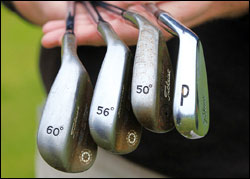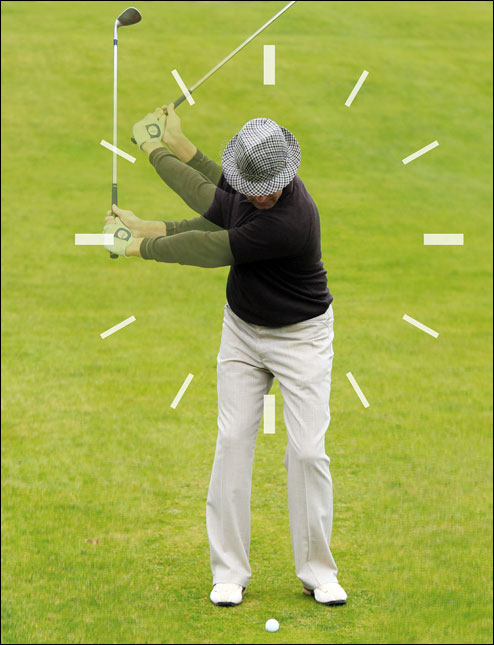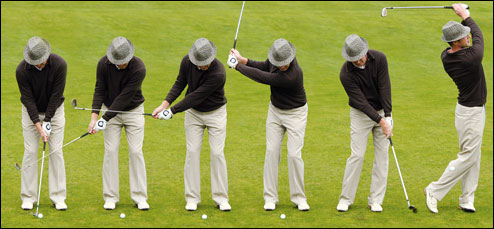Clockface Wedge Distance Principle
Instruction by Steve Cowle
Inaugural winner 2007 Trilby Tour
Photography: David Cannon
How would you like to consistently get the ball inside 10 feet from within wedge range? I’m talking about those critical ‘scoring’ shots from, say, 120 yards and in? Just imagine how many shots you could save in a typical round.
The most common fault amateurs make when faced with what I call ‘scoring’ approach shots is deceleration into the ball – especially on any kind of ‘half’ shot when you are trying to take something off the maximum distance you could hit a particular club. Any time you decelerate you risk making a poor contact and that simply leads to inconsistency.
The method I advocate eliminates that problem. This method uses a smooth accelerating stroke which is highly repeatable and holds up in any pressure situation. To properly control your landing distances you need to control your rhythm. Remember, this is not a power swing designed to hit it the ball a long way. As a rule, I use only 75% of my full power on these shots – and I urge you to do the same to enjoy a softer flight, greater feel and more control on the trajectory of the shot and its landing.

Clockface Wedge Distance Principle
Working on your wedge game is all about developing a scoring ‘system’. Because this is such a vital aspect of the game, I carry four different wedges and use two distinct distance control swings – a ‘system that gives me 8 accurate yardages between 35 and 120 yards.
THE SET-UP: It is critical that you use the same set-up every time you practice and execute this shot, as only then can you achieve quality feedback and improve. In the 7 years I have been working on this system my distances have barely changed.
BODY ALIGNMENT: Align your feet, knees, hips and shoulders parallel to your ball to target line.
BALL POSITION: Play the ball in the middle of your heels. Then turn your leading foot out by 15 degrees or so – this will open up the hips slightly,making it easier to clear through the ball. [It’s an optical illusion that the ball then appears further back in the stance – but flaring out the left foot helps to promote a consistent strike.]

Clockface Wedge Distance Principle
TIME TO WORK ON A PRO SCORING METHOD
I base all of my distance control shots on my hand position in relation to an imaginary clock face (six o’clock being the ball position). Basically, I work on a 9 o’clock to 3 o’clock swing for all ‘part’ shots of between 35 – 50 yards, increasing this to a 10.30 backswing to 12 o’clock follow-through on all other distance control swings for shots of between 60 and 120 yards. The goal every time is to swing your hands consistently to these positions with the same rhythm. This will give you the feel and control to hit accurate yardages time after time.
When you initially rehearse these moves from the set-up position, I’d suggest practising at first without a club in your hand – just make a few rehearsal moves. This takes the ‘hit’ out of the equation, and so improves your rhythm. When you feel comfortable, move on to hitting pitch shots and measuring your yardages. Take 12 balls to a grass range and work between your scoring clubs – i.e. your favourite wedges. Once you have hit all 12 balls with that relaxed, easy swing, pace out to the centre of the cluster (at least I hope it’s a cluster!) and make a note of the distance. Ideally, you want to get hold of a measuring device, so that you can get an accurate number every time. The idea then is that you repeat this process with all of your clubs using these two swing combinations.

Clockface Wedge Distance Principle
Clockface Wedge Distance Principle
One final point: you must hold your follow-through on every shot. Only then can
you get accurate feedback. After just a few practice sessions you will find yourself calling the distance while the ball is still in the air – predicting whether it is short or long of your ‘target’ distance. In other words, you are developing essential feel.
To book a lesson with Steve, visit: www.blackmoorgolf.co.uk
For details on the Trilby Tour, visit: www.williamhunttrilbytour.com
Originally posted in 2010
